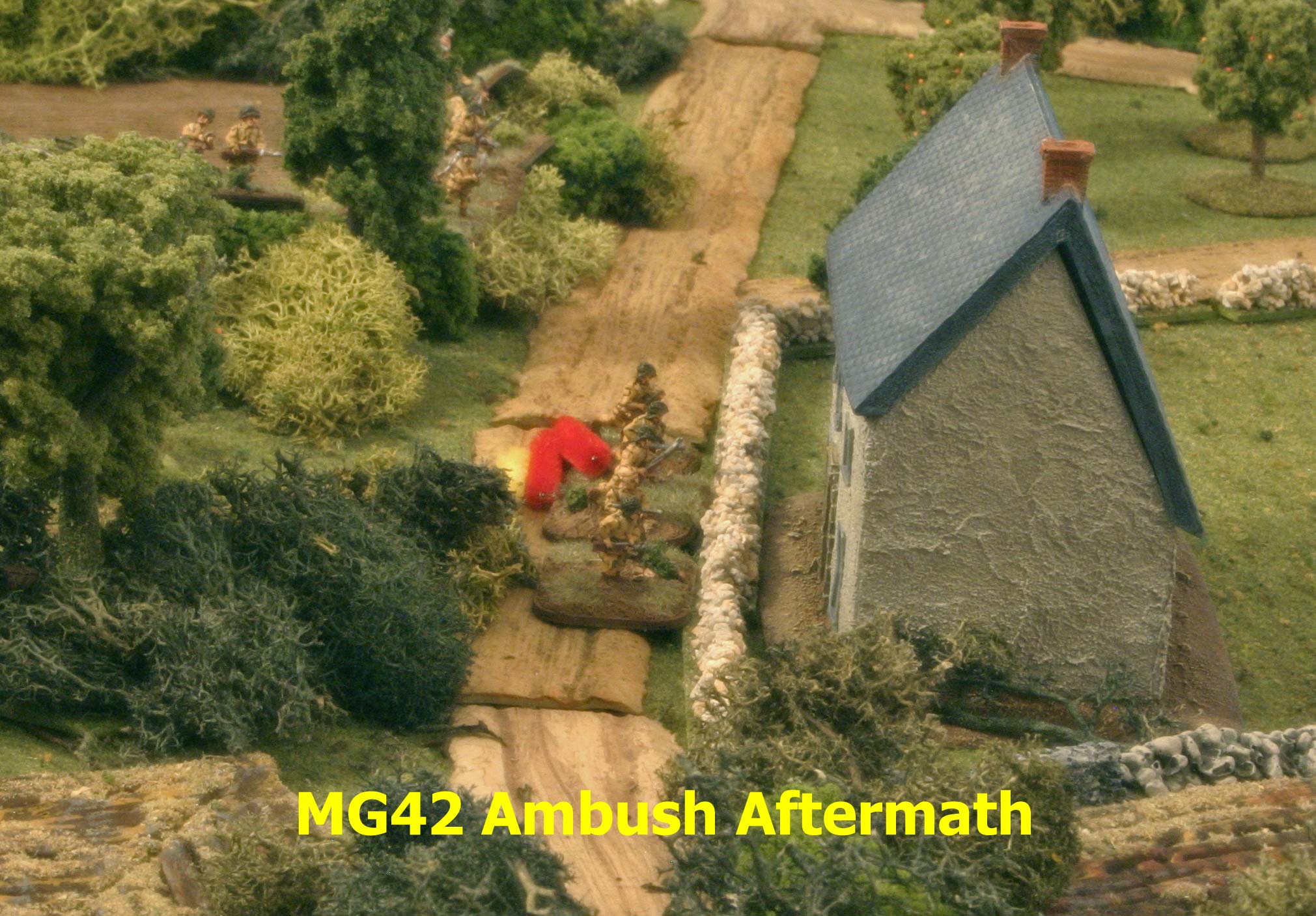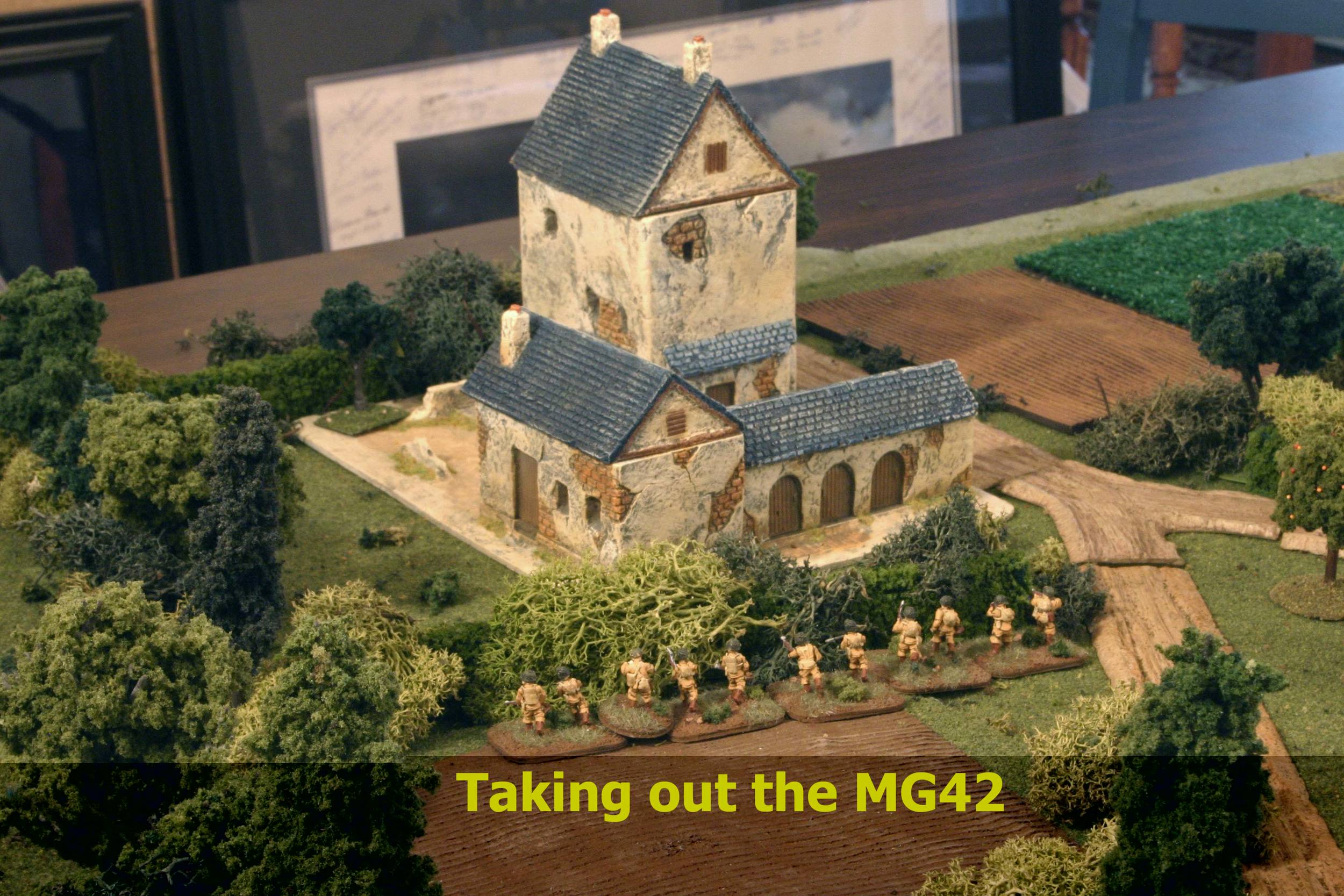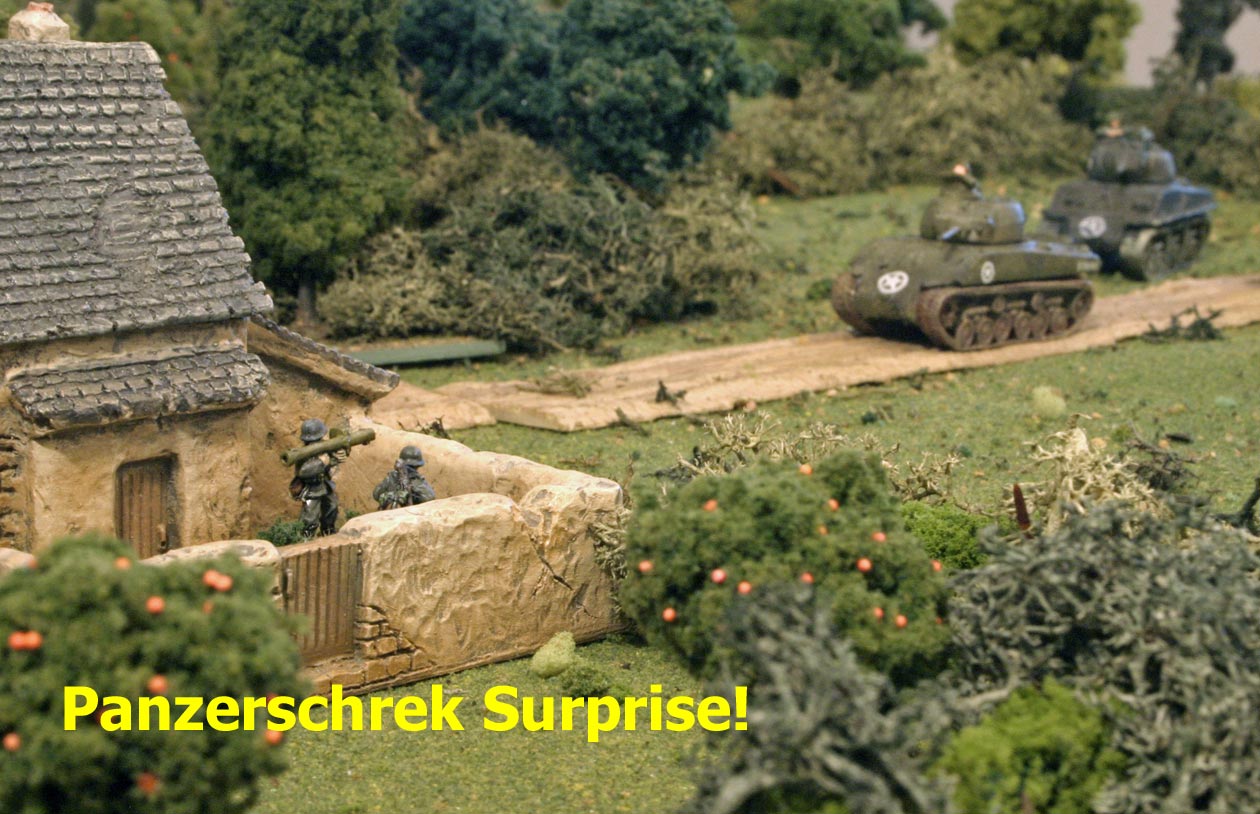Stop Press
6 JUN 44 This morning at 9:00 Paratroopers from the 101st and 82nd Airborne Division launched an attack on the village of Pouppeville. With the support of men from the 8th Infantry Division and Tanks of the 70th Tank Battalion, control of the critical crossroads at the center of the village was achieved. Exit One from Utah Beach is open. Full report to follow.
Curt Daniels
Umpire's Report
From a window in a three story building in the centre of the village of Pouppeville, Leutnant Fritz Siegelmier of the 3rd Battalion 1058th Grenadier Regiment, looked nervously down the road towards the beach. It was 0855 on a gray and cloudy morning. For several hours, the explosive sounds of battle had been coming from that direction but still no visible sign of the invading allied soldiers. "What was happening down that road?" He wondered silently. As he lit a cigarette, he mentally re-examined the placement of his small command. His first platoon occupied the large building in which he was standing; the second was spread among the small houses north of the village crossroads. He had dispersed the elements of the headquarters squad around the village. One MG42 was in the 3 story farmhouse that dominated the northern and western approaches, a second MMG, also on a third story, was positioned directly across the street. It would provide excellent coverage of the main road. His panzerschrek team was in the courtyard of the last house on the eastern edge of the village, a good position should any enemy armour approach on the road from the beach. In a position that gave them a 360 degree field of fire, his mortar platoon was amongst the bocage at the western edge of Pouppeville. His deployment was good but he feared that his numbers were too small especially if the reports of American fallschirmjagers were true.
Slowly and silently the American paratroopers crept across the road and up against the thick hedgerow lining the edge of the pasture west of the village. Lieutenant Colonel Julian J. Ewell's eyes scanned the men from the 101st and 82nd airborne divisions who earlier that morning, he had organized into a command from the paratroopers scattered all over the countryside near his drop zone. He didn't know the men from the 82nd but he knew they were as well trained as his men of the 101st. Confidently he signalled his platoon to move into the bocage, the tangle of earth, shrubs and trees that defined and compartmentalized the Norman landscape. Ewell disappeared with the first and second squads into the bocage on the left. As Sergeant William Burns led the third platoon straight forward into the hedgerow, both men's government issued wristwatches read 0900.
The men of the German mortar squad sat around their weapons. Their NCO was in the hedgerow to their front, looking through his binoculars in the direction of the village, when they heard the first noises to their rear. They grabbed for their small arms as nearly a dozen paratroopers burst from the bocage, firing as they charged toward the surprised grenadiers. The Germans returned fire and ran for an opening in their side of the hedgerow. Half of them managed to sprint across the road and dive behind a rock wall. One paratrooper was down and three Germans were dead. Burns' squad had stumbled into the German mortars and drawn first blood.
Lt. Siegelmier had a sinking feeling in the pit of his stomach as he heard the gunfire erupting not from the beach side of the village but from the fields to the west where he had placed the mortar platoon. Sticking his head out the window he saw three grenadiers diving for the cover of a rock wall. There was only one enemy that could have come from inland - fallschirmjagers.
Burn's men quickly occupied the hedgerow in front of them and began firing on the Germans behind the rock wall. The grenadiers returned fire but their meagre fire was no match for what the paratroopers could dish out. The one surviving German from the mortar squad crawled away on his belly. He would fight no more today.
Ewell and his men were in the middle of a rectangular ploughed field enclosed on all sides by bocage when they heard the shooting begin. Quickly second squad moved into the bocage in the direction of the village. First squad took up a position to their left. They could now see the village but could not spot the enemy.
An occasional shot rang out from a German sniper somewhere in the village. The sniper repeatedly attempted to pick off the officers of first platoon without any success.
From their position in the large house at the northern edge of the village the MG42 team could see their countrymen dying by the rock wall but could not see exactly who was firing. Under orders to conserve their ammo the Feldwebel refused to fire blindly. He looked further south and thought he saw some Americans moving in the bocage near the edge of the village but again no good targets exposed themselves. Suddenly he saw the enemy moving in a field to his right. He ordered his men to bring the machine gun to bear on the Americans. He was about to give the order to fire when he saw a different group of Americans overconfidently move out of the bocage, into the road and directly into the killing zone. As the Americans advanced to the rock wall the machine gun tracked them.
The second squad from first platoon knelt in their new position behind the rock wall. Simultaneously, a high pitched ripping sound, the pinging of hot steel on rock and the screaming of wounded men exploded into the air as the squad was torn to pieces by the fire from the German machine gun. Half of the squad was killed in the ambush. The inexperienced Americans had paid a steep price for this lesson in the power of sustained fire from an MG42.
Ewell reacted quickly to the machine gun fire moving his men across the field and into the hedgerow. Out-buildings plus the bocage gave him a protected fire position to attack the machine gun.
Excited by possibility of finishing off the Americans pinned down at the rock wall and attacking the rest of the platoon in the rear as they attempted to take out the machine gun, Feldwebel Albert Innsbruch ordered his second platoon to abandon their hidden positions in the houses and advance on the enemy.
From his vantage point, an astounded Siegelmier watched as Innsbruch abandoned his defence positions. His attempts to countermand Innsbruch's orders were too late. While Siegelmier was distracted by these actions a second platoon of paratroopers commanded by Lieutenant John W. Atkinson stealthily advanced into position on the south side of the village.
As Innsbruch moved his men forward, the Americans under Burns crossed the road and advanced into the hedgerows facing the main buildings of the village. Ewell's squad engaged in a fire fight with the MG42 while Innsbruch attacked the decimated squad at the rock wall. Innsbruch men made quick work of eliminating the paratroopers at the wall.
Ewell continued his fire on the MG42 whose return fire gradually slackened. Burns' men sprinted across a small field and stormed into the first building in the village proper. It was unoccupied. Innsbruch's men could not prevent this advance but did move into a new position and brought fire on the building. The second paratrooper platoon was now in the southern bocage behind the village centre and began to fire on Siegelmier's first platoon.
As the firefight between Siegelmier's men and Atkinson's command intensified, the machine gun on the North end of the village was silenced by Ewell's men, who quickly took shelter in the farm buildings as protection against fire from the village. The firefight between Burns' men and Innsbruch's continued with the Germans receiving the worst of it as they were in the open with some cover but were fighting against men inside the thick Norman buildings. Above the din of the small arms fire the Germans in the eastern part of the village began to hear the noise of vehicle engines.
An out of breath runner burst into the room where Lt. Siegelmier was observing the fire from his platoon. He shouted two words, "American Panzers" "From the Beach?" Siegelmier shouted back. "Yes. Three of them!" The runner saluted and ran out of the room. After a moment of thought the Leutnant ran down the stairs and ignoring the enemy fire, out the back door and into the house next door.
The two Germans crouching in the courtyard with the loaded Panzerschrek could see three M4 Shermans advancing slowly towards them. The fields on both sides of the road were filled with American soldiers advancing inland from Utah Beach. The lead Sherman rolled to a stop and fired a round into the house, debris rained into the courtyard killing the Panzerschrek loader. The gunner calmly took aim on the front of the American tank. The rocket propelled charge struck the tank just above the white star and failed to penetrate.
The second platoon of paratroopers poured their fire into the building and the Germans returned the fire with equal intensity. Both sides were taking heavy casualties but the superior numbers of paratroopers began to weaken the Germans. With the first platoon of infantry up from the beach in position to fire into the centre of the village and a second platoon closing in fast plus the tanks now shelling the buildings the situation for the Germans was hopeless. Recognizing this Lt. Siegelmier emerged from the building with a white flag of truce. Lt. Colonel Ewell met Siegeimier on the street in the center of the village and accepted the German surrender. By noon Pouppeville belonged to the Americans. Exit One from Utah Beach was open.
Curt Daniels




















